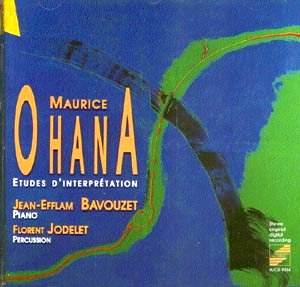|
|
Search MusicWeb Here |
|
 |
||
|
Founder:
Len Mullenger (1942-2025) Editor
in Chief:John Quinn
|
|
|
Search MusicWeb Here |
|
 |
||
|
Founder:
Len Mullenger (1942-2025) Editor
in Chief:John Quinn
|
 |
Maurice
OHANA (1914-1992) Douze Etudes d’Interpretation pour piano Set 1(1981-2) Set 2 (1984-5) Recorded at the Abbé Royale de Fonteyrand, October 1995 |
| CD available for post-free online mail-order or you may download individual tracks. For some labels you can download the entire CD with a single click and make HUGE savings. The price you see is the price you pay! The full booklet notes are available on-line. | |
|
NOTE • Click on the button and you can buy the disc or read the booklet details • You can also access each track which you may then sample or down load. • Further Information. |
|
|
Maurice Ohana is a fascinating figure in 20th century French music. I first came across his work about 12 years ago. I was gripped by the orchestral work ‘Le livre de Prodiges’ of 1979 (Erato 2292-45503-2). The angel of inspiration that touched Olivier Messiaen also touched Ohana. However there is another aspect to his work not often present in that orchestral work but which is certainly found in others. This is his love of and fascination for African music. This led to his use of quarter-tones and of percussion instruments..
These interests are found also in the next work I investigated ‘Avoaha’ (1991) for vocal ensemble and percussion (Opus 111 Ops 30-109) with its texts in African and, just recently, ‘Office des Oracles’ of 1974 (Opus 111 Ops 30-246). This partially takes its inspiration from Afro-Cuban ceremonial; again scored for voices and percussion.
With his emphasis on percussion it should seem to be no big surprise that the last two of these piano studies has an equal role for a percussionist who plays a variety of instruments, including tam-tams, Chinese cymbals, bongos and a bell-tree!
It’s interesting, briefly, to consider two other recent sets of piano studies. Those of Ligeti are, I believe, still work in progress. The recording by Pierre-Laurent Aimard on Sony (SK 62308) is very fine indeed. Ligeti puts the studies into two groups: the first is a group of six (1985) the second, a group of eight (1988-93), are still developing. Ligeti draws on a wide variety of techniques and styles. He also is interested in African rhythms as in ‘Automne a Varsovie’ (set 1 no 6). Ligeti is also drawn to Conlon Nancarrow’s Studies for player piano (1960s), which are fiercely difficult with their use of polyrhythms (RCA 09026 61180-2).
Maurice Ohana is not interested in compositional techniques for their own sake. His fascination, like that of many French composers of the last century, is with sonority. So these are studies almost entirely in sonority. Sometimes these are engendered by rhythmic displays but more often by a sheer joy of sound for its own sake, just like Debussy, even Boulez, and certainly Messiaen before him. Perhaps the Messiaen of the Preludes (1929) comes to mind and the Debussy of his remarkable Studies (1915). Although influences are easy to spot at the end of it lies a very individual voice, which surfaces regularly and yet quietly and modestly, through a haze of colour.
So to give you three brief examples; No 2 ‘Mouvements paralleles’ begins with the hands playing a melody in minor 9ths five octaves apart, before changing into a brief, fast Toccata. Book 2 no. 1 in memory of Bartók has a pure "diatonic opening melody which eventually" becomes "stuffed with dense chords". The performer is asked "to ‘colour’ the sound so that a marimba is conjured up".
Book 2 no 3 ‘Contrepoints libres’ is notated on superimposed staves and is barless. It develops with trills, superimposed clusters and fast runs but began with delicate coruscating lines in counterpoint with a static bass. So many nuances, so many new piano sounds - it’s difficult not to go on.
It seems to me that Jean-Efflam Bavouzet is an ideal interpreter of this music. His biography is given in the booklet but significantly he was friend of the composer’s and has played Stockhausen. He knows the music intimately, which is vital.
Speaking of the booklet notes by Harry Halbreich, I found
them extensive and useful but my wife, a non-musician found them too technical.
Each study is discussed in some detail and a careful reading proves that
each piece has its own sound-world and character. The recording made at
this favourite venue of various French labels, is in every way quite excellent.
Gary Higginson see also review by Peter Grahame Woolf
|
|
ADDITIONAL INFORMATION •
You can sample only 30 seconds (or 15% if that is longer) of a given track. Select from the View tracks list. Each sample will normally start from the beginning but you can drag the slider to any position before pressing play. • PLEASE NOTE: If you are behind a firewall and the sound is prematurely terminated you may need to register Ludwig as a trusted source with your firewall software.
•You will need Quicktime to hear sound samples. Get a free Quicktime download here • If you cannot see the "Sample All Tracks" button you need to download Flash from here.
|
|
|
Return to Index |